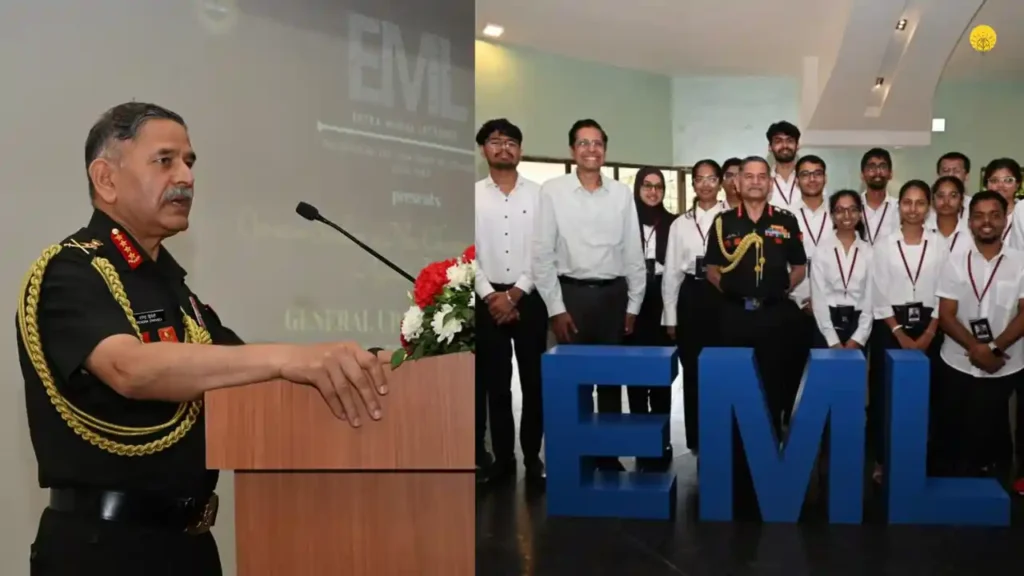New Delhi: In a monumental stride towards achieving Atmanirbharta (self-reliance) in defence technology, the Indian Army, in collaboration with the prestigious Indian Institute of Technology (IIT) Madras, inaugurated the ‘Agnishodh’ Indian Army Research Cell (IARC) on August 4, 2025. The state-of-the-art research facility, located on the IIT Madras campus in Chennai, was formally launched by General Upendra Dwivedi, Chief of the Army Staff (COAS), during his two-day visit to the city. This initiative marks a pivotal moment in India’s journey towards modernizing its defence capabilities and fostering indigenous technological innovation under the guiding principle of “Swadeshikaran Se Sashaktikaran” (Empowerment through Self-Reliance).

A Strategic Partnership for Defence Modernization
The establishment of the Agnishodh Research Cell aligns with the Indian Army’s broader transformation framework, which is anchored on the Five Pillars of Transformation: Technology Absorption, Structural Changes, Human Resource Development, Increasing Cohesion between the Three Services, and Modernisation and Technology Infusion. The Agnishodh initiative specifically advances the pillar of Modernisation and Technology Infusion, aiming to bridge the gap between academic research and real-time operational applications in the defence sector.
The research centre is designed to convert lab-scale innovations into deployable, field-ready technologies, addressing the evolving needs of modern warfare. By leveraging IIT Madras’s academic excellence and cutting-edge research capabilities, Agnishodh seeks to empower the Indian Armed Forces with advanced tools and systems to tackle emerging challenges in both conventional and non-conventional domains.
The Need for Defence Modernization
The urgency for defence modernization is underscored by several global and regional factors. According to data from the Stockholm International Peace Research Institute (SIPRI), global military expenditure reached a staggering US$2,718 billion in 2024, reflecting a 9.4% increase in real terms from 2023. This surge highlights the growing importance of advanced military technologies in maintaining strategic superiority.
Recent conflicts, including India’s engagements with Pakistan, have exposed critical gaps in non-kinetic warfare capabilities, emphasizing the need for innovation in areas such as cyber warfare, space, artificial intelligence (AI), hypersonic technologies, and robotics. The evolving nature of warfare, characterized by fifth-generation conflicts driven by non-contact warfare, strategic tempo, and psychological dominance, demands a robust and modernized defence ecosystem. Emerging domains like cybersecurity and unmanned aerial systems require specialized knowledge of tactics, techniques, and procedures to ensure operational readiness.
The Indian Army’s commitment to self-reliance is further driven by the rising application of diverse military technologies in global conflicts. Developing nations, including India, must strengthen and modernize their defence systems to counter adversaries effectively and maintain strategic autonomy.
General Upendra Dwivedi’s Vision for Agnishodh
During the inauguration ceremony, General Upendra Dwivedi addressed a gathering at IIT Madras on the theme “Operation Sindoor – A New Chapter in India’s Fight Against Terrorism.” He described Operation Sindoor as a landmark, intelligence-driven operation that redefined India’s counter-terrorism doctrine. Spanning 88 hours, the operation was unprecedented in its scale, range, depth, and strategic impact, executed across the Diplomatic, Informational, Military, and Economic (DIME) spectrum. The tri-services offensive showcased India’s ability to deliver precise, punitive, and coordinated action, compelling Pakistan to seek a ceasefire within 88 hours.
General Dwivedi emphasized the transformative journey of the Indian Army, particularly in preparing for grey zone conflicts and fifth-generation warfare. He highlighted the need for a blend of conventional strength and modern capabilities, famously stating, “Boots must share space with bots.” This underscores the Army’s focus on integrating advanced technologies like AI, quantum computing, and unmanned systems with traditional military strategies.
The COAS lauded IIT Madras for its excellence in defence research, citing ongoing initiatives like Project SAMBHAV and additive manufacturing partnerships with Army Base Workshops as benchmarks for innovation. He also acknowledged the Indian Army’s collaborations with other premier institutions, including IIT Delhi, IIT Kanpur, and the Indian Institute of Science (IISc) Bengaluru, which have harnessed academic innovations to strengthen defence capabilities.
General Dwivedi outlined key national technology missions, such as INDIAai, Chip-to-Startup, and Project QuILA, with the Military College of Telecommunication Engineering (MCTE) Mhow as a strategic partner. These collaborations aim to foster indigenous technological development and reduce reliance on foreign systems. He concluded by expressing confidence that Agnishodh would transform academic excellence into battlefield innovation, paving the way for India’s vision of Viksit Bharat 2047 (Developed India by 2047).
Key Initiatives for Defence Modernization
The Agnishodh Research Cell builds on several existing initiatives aimed at fostering innovation and self-reliance in India’s defence sector:
- Innovations for Defence Excellence (iDEX): Launched in 2018, iDEX engages micro, small, and medium enterprises (MSMEs), startups, individual innovators, R&D institutes, and academia to develop cutting-edge defence technologies. Sub-schemes like Acing Development of Innovative Technologies with iDEX (ADITI) further accelerate innovation by providing funding and support to promising projects.
- Self-Reliant Initiatives through Joint Action (SRIJAN): Spearheaded by the Department of Defence Production (DDP), SRIJAN promotes indigenous manufacturing through programs like MAKE Projects. These projects are categorized into Government-Funded, Industry-Funded, and Manufactured in India through Transfer of Technology (ToT) initiatives, encouraging collaboration between public and private sectors.
- Policy Reforms: The Indian government has liberalized its Foreign Direct Investment (FDI) policy, allowing up to 74% FDI through the automatic route and above 74% through the government route. Additionally, the Ministry of Defence has declared 2025 as the ‘Year of Reforms,’ signaling a renewed focus on structural and technological advancements in the defence sector.
Collaboration with IIT Madras Research Park
The Agnishodh Research Cell will operate in close collaboration with the IIT Madras Research Park, a hub for innovation and industry-academia partnerships. It will work alongside entities like the Advanced Manufacturing Technology Development Centre (AMTDC) and Pravartak Technologies Foundation to translate lab-scale innovations into deployable technologies. This synergy will enable the rapid development and testing of advanced systems, ensuring they meet the operational needs of the Indian Armed Forces.
A key focus of Agnishodh will be upskilling military personnel in emerging domains such as additive manufacturing, cybersecurity, quantum computing, wireless communication, and unmanned aerial systems. By building a tech-empowered human resource base, the research centre aims to create a future-ready force capable of tackling the complexities of modern warfare.
Visit to Officers Training Academy (OTA) Chennai
During his two-day visit, General Dwivedi also visited the Officers Training Academy (OTA) in Chennai, where he was briefed on the academy’s infrastructure, modern training methodologies, and initiatives to prepare future military leaders. He commended the instructional staff for fostering excellence and instilling core military values among cadets.
Addressing OTA officers, the COAS reflected on the changing character of warfare, marked by grey zone conflicts and the democratization of technology. He reiterated the significance of Operation Sindoor as a demonstration of India’s ability to deliver integrated and precise military action. General Dwivedi emphasized the need for future leaders to be adept in both conventional and technological domains, preparing them for the challenges of hybrid warfare.
Honoring Veterans and Nation-Building
In a heartfelt gesture, General Dwivedi interacted with a gathering of veterans during his visit, acknowledging their enduring contributions to the nation and the Armed Forces. He felicitated four distinguished ex-servicemen with Veteran Achievers Awards, honoring their selfless service and continued commitment to nation-building. This recognition underscores the Indian Army’s deep respect for its veterans and their role in shaping the nation’s defence legacy.
Agnishodh: A Catalyst for Viksit Bharat 2047
The inauguration of the Agnishodh Research Cell marks a significant milestone in India’s quest for self-reliance in defence technology. By fostering collaboration between the Indian Army and IIT Madras, the initiative is poised to drive innovation, modernize defence systems, and empower military personnel with cutting-edge skills. As India navigates the complexities of modern warfare, Agnishodh will serve as a catalyst for transforming academic research into battlefield-ready solutions, aligning with the nation’s vision of becoming a developed, self-reliant power by 2047.
With its focus on emerging technologies, policy reforms, and strategic partnerships, the Indian Army is setting a new benchmark for defence modernization. The Agnishodh Research Cell, under the leadership of General Upendra Dwivedi and in collaboration with IIT Madras, is a testament to India’s unwavering commitment to “Swadeshikaran Se Sashaktikaran,” ensuring a stronger, more resilient defence ecosystem for the future.
Frequently Asked Questions (FAQs)
1. What is the Agnishodh Research Cell, and what is its purpose?
The Agnishodh Research Cell, also known as the Indian Army Research Cell (IARC), is a collaborative initiative between the Indian Army and IIT Madras, inaugurated on August 4, 2025. Its primary purpose is to advance self-reliance in defence technology under the vision of “Swadeshikaran Se Sashaktikaran” (Empowerment through Self-Reliance). The centre aims to convert lab-scale innovations into deployable, field-ready technologies, focusing on modernizing India’s defence capabilities through advancements in areas like cybersecurity, quantum computing, additive manufacturing, wireless communication, and unmanned aerial systems.
2. How does Agnishodh align with the Indian Army’s transformation goals?
Agnishodh supports the Indian Army’s Five Pillars of Transformation: Technology Absorption, Structural Changes, Human Resource Development, Increasing Cohesion between the Three Services, and Modernisation and Technology Infusion. The research cell specifically focuses on the pillar of Modernisation and Technology Infusion by integrating academic research with real-time operational applications, ensuring the Armed Forces are equipped to handle fifth-generation conflicts and emerging domains like cyber and space warfare.
3. What role does IIT Madras play in the Agnishodh initiative?
IIT Madras provides its academic expertise and research infrastructure, including collaboration with the IIT Madras Research Park, the Advanced Manufacturing Technology Development Centre (AMTDC), and Pravartak Technologies Foundation. These partnerships enable Agnishodh to develop cutting-edge technologies and upskill military personnel in critical areas such as artificial intelligence, robotics, and hypersonics, transforming academic innovations into battlefield-ready solutions.
4. How does Agnishodh contribute to India’s self-reliance in defence?
Agnishodh promotes Atmanirbharta by fostering indigenous innovation through collaborations with national technology missions like INDIAai, Chip-to-Startup, and Project QuILA. It builds on initiatives like Innovations for Defence Excellence (iDEX) and Self-Reliant Initiatives through Joint Action (SRIJAN), engaging startups, MSMEs, and academia to develop homegrown defence technologies. The centre also supports policy reforms, such as liberalized FDI policies, to reduce reliance on foreign systems.
5. What is the significance of Operation Sindoor in the context of Agnishodh?
Operation Sindoor, highlighted by General Upendra Dwivedi during the inauguration, was a landmark 88-hour tri-services operation that showcased India’s ability to deliver precise, coordinated, and punitive action, compelling Pakistan to seek a ceasefire. It underscored the need for modernized defence systems and technologies, which Agnishodh aims to develop. The operation emphasized the integration of conventional and modern capabilities, aligning with Agnishodh’s goal of preparing the Indian Army for future conflicts where “boots must share space with bots.”

